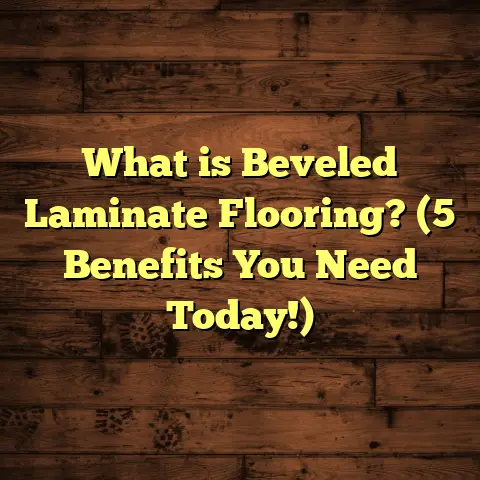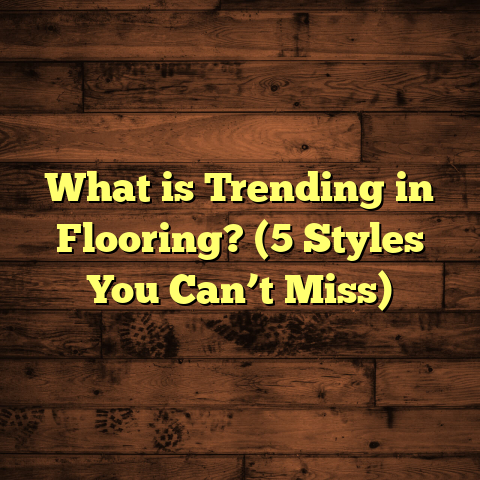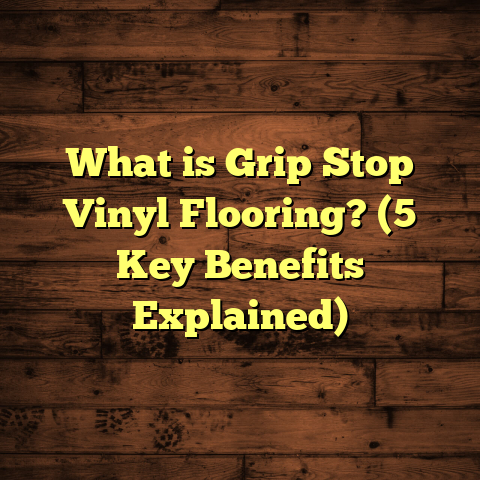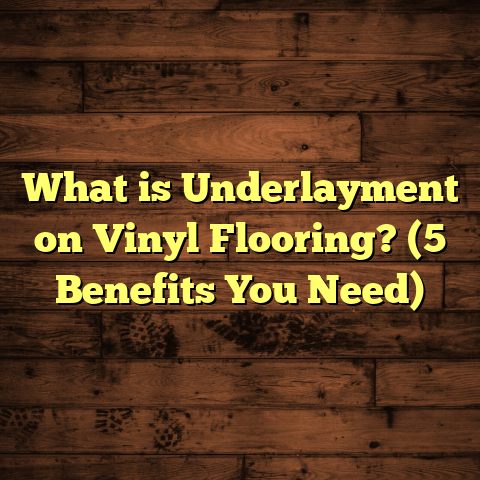What is Low VOC Flooring? (5 Benefits for a Healthier Home)
I want to start with a story that really changed how I think about flooring and indoor air quality. A few years ago, I was hired by a young couple who had just bought their first home. They were excited about the renovation but worried because their daughter was having constant allergy attacks. The old floors had been covered up with layers of carpet and laminate over the years, and the air inside the house was stuffy with a faint chemical smell. After some research and testing, we decided to replace all the flooring with low VOC materials. The difference was remarkable—within weeks, their daughter’s symptoms eased, and the whole family noticed how much fresher the air felt. This experience sparked my passion for low VOC flooring and made me realize how much of a difference it can really make.
Over time, I’ve installed and worked with hundreds of projects involving low VOC flooring. I want to share everything I’ve learned with you—what low VOC flooring actually means, why it matters so much, and the five biggest benefits it can bring to your home’s health. Along the way, I’ll share some data points, personal insights, and practical tips to help you make informed choices.
What is Low VOC Flooring?
Let’s get right into it: What is low VOC flooring? The term VOC stands for volatile organic compounds. These are chemicals that easily evaporate into the air at room temperature. Many building materials—paint, adhesives, finishes, carpets, and yes, flooring products—can release VOCs into your home’s air.
The problem is that many VOCs can cause health issues ranging from mild irritation to serious long-term problems. Some common VOCs include formaldehyde, benzene, and toluene. You might recognize formaldehyde from warnings about certain pressed wood products or older furniture.
Low VOC flooring means flooring materials designed or manufactured to release very low levels of these volatile organic compounds into your indoor air. This is generally achieved by using safer chemicals in adhesives and finishes, choosing natural or less chemically intensive materials, and meeting strict testing standards for emissions.
But here’s what often surprises people: low VOC flooring isn’t limited to just one type of floor. It can be hardwood, laminate, vinyl, cork, bamboo, or carpet—the key is in how it’s made and what chemicals are used.
For example:
- Traditional vinyl flooring has sometimes been associated with phthalates and plasticizers that off-gas VOCs. Newer low VOC vinyl products use reformulated materials and safer adhesives.
- Engineered hardwood finished with water-based sealants emits fewer VOCs compared to older oil-based finishes.
- Cork flooring is naturally antimicrobial and tends to have very low emissions.
- Carpet can be a tricky one because synthetic fibers and glues can emit VOCs—but there are certified low VOC carpet options made with natural fibers or better adhesives.
In my work, I always ask manufacturers for test reports showing emissions data—products with certifications like GREENGUARD Gold or FloorScore have passed rigorous standards limiting chemical emissions.
Why Should You Care About VOCs in Your Flooring?
You might wonder: if I don’t smell anything strong in my new floor, is there really a problem? The answer is yes—and no.
Some VOCs have strong odors you can smell immediately after installation—this is called “off-gassing.” But others are odorless or below your detection threshold yet still present health risks over time.
According to the U.S. Environmental Protection Agency (EPA), indoor air can be 2 to 5 times more polluted than outdoor air, mainly due to emissions from building materials like flooring. This is because indoor spaces are often sealed tightly to conserve energy, trapping pollutants inside.
I’ve seen this in my own projects when clients complain about headaches, dizziness, or respiratory symptoms after installing new floors—symptoms which sometimes disappear once they switch to low VOC alternatives.
Here are some important facts:
- Formaldehyde exposure is linked to irritation of eyes, nose, throat, headaches, and even increased cancer risk.
- A study in the Journal of Exposure Science & Environmental Epidemiology found homes using low VOC materials had up to 60% less airborne formaldehyde than homes with conventional materials.
- Children, elderly people, and those with asthma or allergies are especially vulnerable to VOC exposure.
- Even short-term exposure during installation can cause discomfort for homeowners and contractors alike.
When I work on projects involving families with health concerns or schools and daycare centers, I always recommend prioritizing low VOC flooring because the benefits go beyond aesthetics—they protect your health every day.
The 5 Benefits of Low VOC Flooring for a Healthier Home
Based on years of experience and research, I want to highlight five key benefits that low VOC flooring offers. These aren’t just marketing points—they’re real advantages that you can see and feel in your home.
1. Cleaner Indoor Air Quality
This is the biggest reason most people choose low VOC flooring. Cleaner air inside your home means fewer pollutants circulating around you daily.
Many traditional flooring materials release gases like formaldehyde for months or even years after installation. This continuous off-gassing keeps adding chemicals to your breathing space.
Low VOC floors emit far fewer harmful compounds. For example:
- Water-based finishes on hardwood release up to 90% less VOCs compared to oil-based finishes.
- Low VOC vinyl flooring formulations reduce emissions by 30–50% compared to older vinyl types.
- Cork flooring naturally emits minimal VOCs since it’s harvested from tree bark without toxic chemicals.
I’ve installed low VOC floors in homes where family members reported immediate relief from chronic headaches or sinus problems after switching floors. The difference is palpable—the air feels fresher, lighter, and less irritating.
2. Lower Health Risks Over Time
VOCs don’t just cause short-term irritation—they also contribute to long-term health risks like respiratory diseases and even some cancers.
The EPA classifies formaldehyde as a probable human carcinogen. Long-term exposure to high levels of VOCs can increase risks of asthma development and worsen existing respiratory conditions.
In one case study I followed involving a daycare center (with about 60 children), staff noticed frequent headaches and nausea after new carpet installation. Switching to certified low VOC rubber flooring reduced complaints by over 50% within two months.
For families with asthma or chemical sensitivities, low VOC flooring can be life-changing. It reduces triggers and improves quality of life by minimizing exposure to irritants.
3. Safer for Installers and Renovators
You might not think much about installers breathing in fumes during floor installation—but it’s a real concern.
Traditional adhesives and finishes emit strong solvents that can cause headaches, dizziness, eye irritation, or respiratory issues for contractors working in enclosed spaces.
Using low VOC adhesives and water-based finishes reduces this exposure significantly. I’ve noticed crews working on low VOC projects reporting fewer symptoms and feeling more comfortable on site.
This also speeds up work since poor air quality can slow down labor if workers need breaks or ventilation time between steps.
4. Environmentally Friendly Choices
Choosing low VOC flooring often means supporting safer manufacturing processes that prioritize sustainability.
Many eco-friendly floor manufacturers use renewable materials like bamboo or cork harvested responsibly. They avoid harmful chemicals like formaldehyde resins or heavy metals in finishes.
Low VOC products usually come from companies committed to reducing waste, using recycled content, or employing greener energy sources during production.
For example:
- Bamboo harvested every 5-7 years regenerates quickly without replanting.
- Cork bark harvesting doesn’t harm trees and supports forest health.
- Some engineered hardwood uses reclaimed wood scraps combined with non-toxic adhesives.
If you care about your home’s environmental footprint, going low VOC aligns well with green building goals such as LEED certification or WELL Building Standards.
5. Long-Term Cost Savings
At first glance, low VOC flooring may seem more expensive than conventional options—but there are savings that add up over time.
First, healthier indoor air reduces doctor visits and medication costs related to asthma or allergies caused by chemical exposure.
Second, many low VOC floors use higher-quality materials and finishes designed for durability. This means fewer repairs or replacements down the road.
One family I worked with replaced old carpet with low VOC hardwood floors and noticed fewer allergy flare-ups within months—which saved them money on allergy medications alone that first year.
Plus, better indoor air quality can improve sleep quality and overall wellbeing—which translates into less absenteeism from work or school over time (harder to put a price tag on that!).
How Do Manufacturers Make Flooring Low in VOC?
You might be curious how manufacturers actually achieve low VOC levels in their products. It’s a combination of material selection, chemistry adjustments, and rigorous testing.
Here’s a simplified breakdown:
Materials Matter
Natural materials tend to emit fewer VOCs than synthetic ones because they don’t require harsh chemical treatments.
- Cork comes from tree bark processed without toxic additives.
- Bamboo is a natural grass rapidly renewable without pesticides.
- Solid wood can be low emission if finished properly.
- Recycled content reduces chemical use by reusing materials already processed.
Adhesives & Binders
Adhesives often contain solvents that release VOCs during curing. Low VOC adhesives use water-based formulas or bio-based ingredients that evaporate less harmful gases.
For example:
- Traditional glue might contain formaldehyde-based resins.
- Low VOC glue uses polyvinyl acetate (PVA) or other safer compounds.
Finishes & Sealants
Traditional oil-based finishes off-gas chemicals for weeks or months after application.
Water-based finishes dry faster and release fewer toxic fumes—sometimes up to 90% less than oil-based options!
Manufacturers test these finishes under strict protocols to limit emissions before selling them as “low VOC.”
Testing & Certification
Certifications provide independent verification that products meet emission limits:
| Certification | What It Means |
|---|---|
| GREENGUARD Gold | Meets strict chemical emissions limits for indoor environments including schools & healthcare facilities |
| FloorScore | Focuses on emission limits specifically for flooring products |
| CARB Phase 2 | California Air Resources Board’s formaldehyde emission standards for wood products |
When selecting products, I always look for these labels—it’s the best way to avoid greenwashing.
Personal Anecdotes: Real-Life Experiences with Low VOC Flooring
I want to share some stories from my career that highlight why this matters so much beyond just theory:
Story 1: The Allergy-Free Nursery
A young couple wanted to create the safest nursery possible for their newborn baby because allergies ran in the family. We chose cork flooring because it’s naturally antimicrobial and emits almost no VOCs. After installation, the parents reported their baby had fewer skin irritations and breathing issues compared to their last home with standard laminate floors. It was rewarding knowing the floor helped create such a healthy environment for new life.
Story 2: Office Renovation Gone Wrong (Then Right)
I once consulted on an office renovation where the client installed cheap vinyl flooring without considering emissions. Within days employees complained of headaches and fatigue—productivity dropped noticeably. We removed the vinyl and installed a certified low VOC carpet tile option instead. Within two weeks symptoms improved dramatically—and workers appreciated the fresh air quality during long hours inside.
Story 3: DIY Dad’s Mistake
A dad tried DIY laminate installation using off-the-shelf adhesive without checking its chemical content. He ended up with strong odors that lingered for weeks; his kids complained about burning eyes after playing in the living room. After switching to a recommended low VOC adhesive and better ventilation practices during installation next time—problems disappeared quickly.
How Can You Identify & Choose Low VOC Flooring?
Here’s what I tell clients when they ask how to pick the right product:
Ask for Emission Data & Certifications
Don’t rely only on marketing terms like “green” or “non-toxic.” Request independent test results or third-party certification labels such as GREENGUARD Gold or FloorScore.
Consider Material Types
If you want natural options—go cork, bamboo, reclaimed wood—or solid hardwood finished with water-based sealants. Avoid cheap laminate with unknown adhesives or vinyl products lacking transparency on chemical content.
Look Closely at Installation Materials
Adhesives and sealants can be hidden sources of toxins. Choose water-based adhesives labeled as low or zero VOC—and communicate this clearly with your installer.
Ventilation is Key
Even low VOC floors off-gas small amounts initially—make sure you ventilate well during and after installation by opening windows or using fans.
Work With Experienced Installers
Make sure your contractors know how to handle low VOC products properly—wrong installation can increase emissions or damage the floor finish integrity.
Common Questions About Low VOC Flooring
Here are some questions I hear frequently:
Q: Will low VOC flooring smell during installation?
A: Most produce minimal odor compared to traditional materials—but some mild scent may appear initially then fade quickly within days.
Q: Is it more expensive?
A: Sometimes yes—but prices are becoming competitive as demand rises. Consider health savings over time too!
Q: Can I install low VOC floors myself?
A: Yes! Many DIY-friendly options exist but pay careful attention to adhesives used—and ventilate well during installation.
Q: How long does off-gassing last?
A: Typically days or weeks max for certified low VOC products—not months like older floors with oil-based finishes or formaldehyde resins.
Final Thoughts on Low VOC Flooring
Choosing low VOC flooring is more than a design trend—it’s about creating a healthier home where your family can breathe easy every day.
From improved air quality and reduced health risks to better safety during installation and environmental benefits—the advantages add up quickly.
If you are renovating or building new space, take time researching your options carefully. Ask manufacturers for test data; prioritize natural materials; insist on certified adhesives; ensure proper ventilation; work with knowledgeable installers who understand these products well.
I’ve seen firsthand how these choices transform homes—from reducing asthma attacks to improving productivity at workspaces—and I’m confident it will make a difference for you too.
If you want advice tailored specifically for your project or need help selecting trusted brands I’ve worked with personally—just ask!





